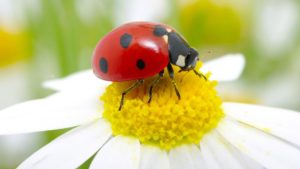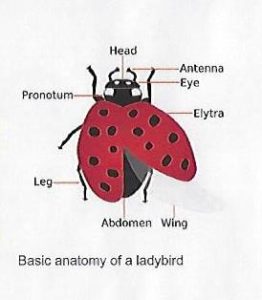This week (March 7th) would have been my sister Cathie’s birthday. She passed away in February, 2012, but her memory and spirit live on in our hearts and minds. She had a particular fondness for ladybugs; so in her honor we formed The Catherine F. Sladowski Memorial Ladybug Sorority, originally comprised of the “ladies” directly related to her by blood (her sister, four nieces and five grand-nieces). This year the privileges of membership were extended to her two brothers, two sons, three nephews, and five grand-nephews. We refer to them as “laddies;” and, yes, of course, there actually are male ladybugs.
 There are more than 5,000 different kinds of ladybugs in the world, and they are common throughout North America. They have round to elliptical dome-shaped bodies and six short legs and are usually red, orange or yellow. Depending on their species, they may have spots, stripes or no markings at all.
There are more than 5,000 different kinds of ladybugs in the world, and they are common throughout North America. They have round to elliptical dome-shaped bodies and six short legs and are usually red, orange or yellow. Depending on their species, they may have spots, stripes or no markings at all.
Coccinellida is derived from the Latin word coccineus meaning “scarlet,” The name “ladybird” originated in Britain where the insects became known as “Our Lady’s bird,” or “the Lady Beetle.” In Christian areas they are associated with the Virgin Mary, and the name the insect bears in some European languages has the same association, for example, the German name Marienkuft translates to “Mary Beetle.” In the USA the name was adapted to “ladybug.” Sometimes the insect is referred to as belonging directly to God: Irish, boin De; Polish, Boza krowka; Russian, Bozhya korovka; Dutch, lieveheersbeestje; all meaning “God’s little cow.”
 Female lady bugs lay their eggs several times in a single year, usually on plants that harbor their prey to increase the likelihood the larvae will find food easily. Eggs hatch in three to four days from clutches numbering from a few to several dozen. The larvae pass through four stages over ten to fourteen days, after which pupation occurs. After a period of several days, the adults become reproductively active and are able to reproduce again. Total life span is one to two years on average.
Female lady bugs lay their eggs several times in a single year, usually on plants that harbor their prey to increase the likelihood the larvae will find food easily. Eggs hatch in three to four days from clutches numbering from a few to several dozen. The larvae pass through four stages over ten to fourteen days, after which pupation occurs. After a period of several days, the adults become reproductively active and are able to reproduce again. Total life span is one to two years on average.
They are best known as predators of aphids and scale insects and a range of serious pests such as the European corn borer, a moth that costs the US agriculture industry more than $1 billion annually in crop losses and population control.
As a family, the coccinellidae was regarded as purely carnivorous, but they are now known to be far more omnivorous than previously thought. Besides their prey they include honeydew, pollen, plant sap, nectar and various fungi in their diet.
In autumn, ladybugs leave their summer feeding sites in fields, forests and yards and search out places to spend the winter. In the spring, when temperatures climb back into the mid sixties, they return to the outdoors.
Ladybirds have long been of interest to children and were immortalized in the popular nursery rhyme:
Ladybird, ladybird, fly away home
Your house is on fire and your children are gone
All except one, and that’s little Anne
For she crept under the warming pan.
Part of a Polish rhyme, Little Ladybirds’ Anthem, “fly away to the sky little ladybird and bring me a piece of bread,” became a saying.
Ladybirds have served as the state insects of Delaware, Massachusetts, New Hampshire, New York, Ohio and Tennessee, though only New York selected a species native to the USA.
Many cultures consider ladybirds to be an omen of good luck. The Turkish name for the insect literally means “good luck bug.” In some countries, including, Russia, Turkey and Italy, the sight of a coccinellida is either a call to make a wish or a sign that a wish will soon be granted. We too believe in the luck of the ladybug and record sightings as they occur.
Wishing you a multitude of blessings and many lucky ladybug appearances this coming season.
Thank you for your interest. To read previous postings and for information on work in progress visit: www.LovEstelle.com
Interesting!
Cute twist on your always lovely writings. /crt
Very interesting and educational.
Thank you for sharing.